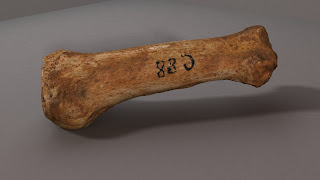In our first post, we showed you raw 3D digitised data of a phalanx bone. What this didn't have was colour - also known as the "texture map". For this project, we have assembled a group of 4 extremely talented animation and modelling students to work on the daunting task of texture mapping hundreds of bones.
Tom Newbold, James Thompson, Patrick Garwood, and Toby Toochukwu have begun work on cleaning the 3D scan data, surfacing, and texture mapping. Below are a few screen shots of a couple of the proximal phalanx bones from subject C88.
We'll be working towards standardised lighting models for the rendered videos and images, so that the colour appearance is uniform. Below is a video of the bone shown in the last two images:
Images of the team will follow shortly.
Monday, 23 May 2011
Tuesday, 17 May 2011
Scanning X-rays
Here is an update by my undergraduate placement student, Rachel, who is helping with digitising the radiographic, photographic and paper archive:
My name is Rachel Holgate and I am a placement student here at Bradford University working under Dr. Jo Buckberry, and also studying Bioarchaeology. I applied for this placement, working in BARC (Biological Anthropological Research Centre), mainly for my curiosity in bones. So far, I have thoroughly enjoyed my time here and it has cemented my interest in osteology and the hope of further study in this area.
 Rachel digitising a radiograph of one of the Chichester skeletons
Rachel digitising a radiograph of one of the Chichester skeletons
My involvement in the From Cemetery to Clinic project has been fantastic. Meetings, dare I say it, have been incredibly interesting and fun. So far, I have been digitising radiographs and coloured slides so that they can be accessed on the web page being created. The task I undertook was very informative from my point of view as an undergraduate student as I was able to see material first hand that is probably the best examples of clinical cases of leprosy, not to mention the opportunity to see the radiographs of the skeletal record from Chichester. I have completed digitising all the clinical radiographs and the radiographs of skeletons from Chichester that have been involved in the 3D scanning process to date. I feel incredibly lucky to be a part of this project and am thoroughly enjoying the experience so far.
My name is Rachel Holgate and I am a placement student here at Bradford University working under Dr. Jo Buckberry, and also studying Bioarchaeology. I applied for this placement, working in BARC (Biological Anthropological Research Centre), mainly for my curiosity in bones. So far, I have thoroughly enjoyed my time here and it has cemented my interest in osteology and the hope of further study in this area.
 Rachel digitising a radiograph of one of the Chichester skeletons
Rachel digitising a radiograph of one of the Chichester skeletonsMy involvement in the From Cemetery to Clinic project has been fantastic. Meetings, dare I say it, have been incredibly interesting and fun. So far, I have been digitising radiographs and coloured slides so that they can be accessed on the web page being created. The task I undertook was very informative from my point of view as an undergraduate student as I was able to see material first hand that is probably the best examples of clinical cases of leprosy, not to mention the opportunity to see the radiographs of the skeletal record from Chichester. I have completed digitising all the clinical radiographs and the radiographs of skeletons from Chichester that have been involved in the 3D scanning process to date. I feel incredibly lucky to be a part of this project and am thoroughly enjoying the experience so far.
Friday, 6 May 2011
First Blog Updates
For our first blog entry I decided to upload our slide which we presented at the Kick-off meeting for the JISC e-content programme on 30th March. This was a fun day, and each project representative had 3 minutes to present their project.
The slide shows one of the early bones we scanned, a proximal phalanx from the right hand of one of our subjects. This bone is interesting because it shows the effects of leprous claw hand which is caused by the leprosy virus attacking the nerves in the arm which results in a fixed flexion of the fingers. The result of this is that over time a volar groove is formed - this groove can be seen near the left edge of the bone as it appears in the images:
In our next blog we'll talk about the progress of the project so far, and show some images of Andy Holland in action with the laser scanner.
Subscribe to:
Comments (Atom)






